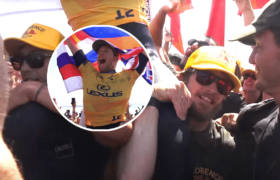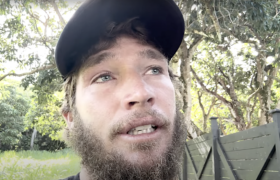"Surf writing has never been more punk or more fun!"
It boggles the mind how quickly the internet forgets but those of a certain age will remember the infamous table jump podcast Ep where BG principal Chas Smith went for the choke out on STAB Editor Ashton Goggans.
It was a watershed moment for surf journalism/writing.
I’m not a podcast guy – I find the format too long, too much wheat to sift through – but I did listen to the whole damn table jump ep, totally transfixed. While the table jump was in the spotlight and got all the attention a lot more meat on that bone was left indigested.
One thing caught my ear and has stuck in the craw. Goggans said how much surf writing meant to him and how he wished to inspire a whole new generation of kiddies into the artform. Chas may even have agreed with him.
I thought: wow! Kids want to be surf writers? Could that be true? Surely not.
Following that I had one of my regular online beefs with surf journalist Nick Carroll, the gist of which was “Fuck Shearer, I hope you never help someone in surf writing”. I thought, most unfair.
I can help! And help with the chief skill one needs to become proficient at.
The hustle.
The Old Legacy Print media gatekeepers were bullshit. I want to mourn them, but just can’t. They locked more talent out than they let in. The gear I read on BG, generally speaking, craps all over the old print dinos. JP Currie, SurfAds, Frontwards Fin Frank, Dogsnuts, Jen See of course, Von Fanningstadt(sic) etc etc.
Funny, sharp, independent.
Surfing, once for vagabonds, now belongs to billionaires according to Derek Hynd. Hard to argue with that. But we are still at the vanguard in two things: online commenting and surf writing. A: Surfers do commenting better than any human species on Earth and B: The future of work is the independent contractor/freelancer, vainly staunching bloodflow as they lose limbs to the onslaught of AI.
Guess who will own the algorithms?
When we are all in Harari’s useless class then we’ll all have to embrace the art form and jump in the steaming jacuzzi of surf writing. How? Don’t do it when you’re young.
Young surf writers are fucking horrible. Except Sabre Norris. I hate child prodigies but she was an amazing interviewer and quirky stylist.
Millennials surf write for a year or three and then go work for the Murdoch press. Spare the people the misery of using your surf writing as an extended resume. Do it the other way round. Work a real job then come in the backdoor with some dirt under your fingernails. Commercial fishing has never been sexier. School teaching has its charms.
Getting paid is a rapidly burning bridge on the current business models. Surf writing is yet to meet its Jeff Bezos so until the day of billionaire patronage arrives it’s better to think of it as writing for it’s own satisfaction.
Or a lead into selling something else.
What leverage do you have in the marketplace of ideas? In a world where even Nick Carroll gets rejected by The Surfer’s Journal, somewhere between nothing and five eighths of fukall.
Lewis Samuels made the pertinent observation that the “house style” tended to gobble up young minds and produce a form of the written word where one piece was almost indistinguishable from the other. Especially in taste and tone.
That’s the only challenge in surf writing. To beat the house on style, or create your own.
Chas Smith beats the house style in every magazine he writes in. D. Rielly created a house style so seductive that a decade after leaving STAB every writer there comes off as a second-rate copy.
Surf media started as a way to promote movies. John Severson kicked off Surfer magazine to promote his 1960 film Surf Fever. Alby Falzon started Tracks in ’73 as a vehicle to drive Morning of the Earth to market. Ozzie Wright sustained a 20-year career on the back of Vaughan Blakey’s Doped Youth movie promoted through Waves magazine.
It makes sense, if you have something to sell, to write about it. The last 30 years of surf writing as PR for the (failed) surf industry might be nothing more than slight aberration of the historical norm.
Surf writing is a beautiful art form. I recommend it highly and thoroughly. In its current incarnation it’s never been more punk or more fun.
How to hustle: go start your own ‘zine and give it away. Fund it with local business ads. Go local then go global. You’re welcome.
*When the local High School Principal found out I wrote surf he asked me to deliver a “career” lecture to high school graduates (true!). Not long after he was caught screwing the staff and exiled to the bush. This is a slightly edited version of the high school graduation speech, never delivered.






